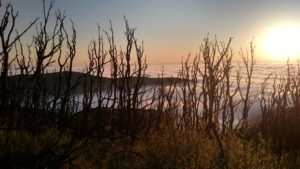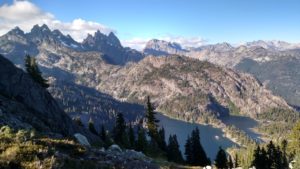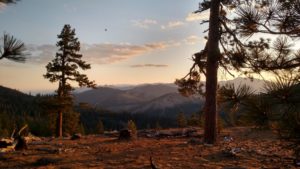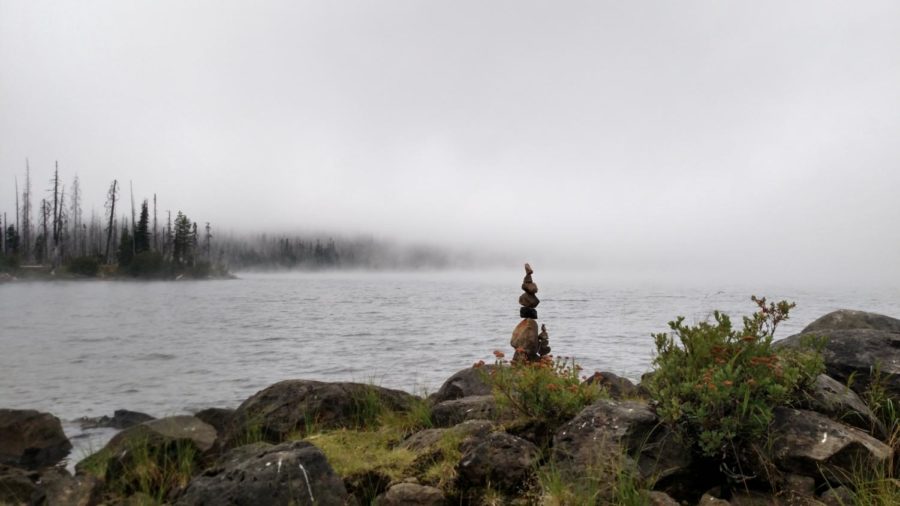All the Rules I Made—then Broke—on the Pacific Crest Trail
When I started my thru-hike on the Pacific Crest Trail at the Mexican border east of San Diego on May 2, 2018, I’d only been backpacking a couple of times before. I’d never hiked more than ten miles in a day, but I was confident that I could handle the twenty-mile days I’d need to reach the end of the 2,652-mile trail in five months before the snow started to fall in the mountains of northern Washington.
I was full of grit. Ready to embrace the suck. I needed this do-or-die attitude to complete the trail. A person can backpack and enjoy it without such rigid (read: masochistic) tendencies, but to finish a thru-hike, I had to put my desire to finish above just about everything else.
That being said, I started the trail with a lot of equally rigid ideas about who I was as a hiker. As much as stubbornness was an asset in bringing me all the way to the Canadian border, I soon learned that flexibility was equally important. I had to learn when to change my mind about the trail, and myself.
Here are four rules I set for myself when I started the PCT, and what I gained when I broke them.
1. Never hike at night.
“I don’t hike at night,” I declared to my new hiking companions. Night hiking was common in the desert to beat the heat that was slowly beginning to climb past 100˚F during the day, but I didn’t want to miss any scenery. I didn’t seem to mind the heat as much as most people. And, admittedly, I was a little scared.
I don’t remember exactly how it started, but if I were to guess, I probably lingered a little longer than intended with some “trail angels” gifting sandwiches and beer at a road crossing. I realized I wasn’t going to make the miles I had planned, an equally important rule, and as sunset faded into darkness, I just kept hiking.
Then there was the moon, or the stars, turning the manzanitas into shadows against the gently glowing sky. The synchronized red lights of the wind turbines flicking off and on. The coyotes in the distance. Even the lingering thought of mountain lions felt a little intoxicating as my long strides carried me through the darkness, occasionally banging my hiking poles together and shouting into the blackness to ward off any large, lurking mammals.
I did not feel like I was missing anything. Just seeing something different.
2. Never cut my miles short.
I had a twenty-mile day planned out of Mammoth Lakes and things were off to a good start before lunch. Unfortunately, I ate an entire bag of Sour Patch Kids and had to lay down for an hour or so to recuperate. While I was dozing in my nausea, a hiker I had never met before came along and introduced herself to my friend, Early, and me with her trail name, Napoleon. We talked for a while and, after my stomach had settled, the three of us set off together.
In the late afternoon, thirteen miles or so from where I’d started that morning, we reached a meadow by a lake deep in the Sierras. Behind the lake was the pass I’d planned to cross that day.
“I usually stop at four o’clock,” Napoleon said, looking at her watch. “And this is a perfect spot.”
I looked at the pass in the distance. It was so hard to give up miles, but Early seemed to want to stop here as well. We were vibing our way into a trail fling, and Napoleon seemed cool, too. We stopped.
We ate dinner on the shore of the lake while the full moon rose in the center of the mountain pass, so big it looked like it must be on a pendulum swinging towards us.
Over the course of my five months on the PCT, I wavered between days when I set hard goals and refused to let myself fall short, and days when I remembered that it was about the journey and stopped well before I intended in order to stay with friends, to set up with a perfect view of the sunset, or just because I was tired and wanted to sleep. Both mentalities served me that summer. I would not have finished the trail without the first, and wouldn’t have enjoyed the trail as much without the second.
Napoleon and Early became the closest thing I had to a “trail family.” We reached Canada together. Four years later, we still text every week. The cost of these four years, and on into the future, was to fall seven miles short one day in June 2018.
3. Never listen to music or podcasts while hiking.
“I don’t listen to anything while I’m hiking,” I told Early and Napoleon. We were 800 or 900 miles into the trail at this point and I was one of the only hikers I knew without headphones. I’m not really a music person in general. I can sit in the car for hours and not notice that I never turned on the radio. Besides, I had practical reasons. With headphones in, I would be less aware of the dangers around me, but also the beauty. And I relied on my phone for GPS maps and photos and could only charge it once a week.
For a few days in northern California, though, I listened to the New Yorker Fiction Podcast. One night, I listened to Kate Walbert read “Pet Milk” by Stuart Dybek. In the story, a young man talks about going to a restaurant with his girlfriend in the evenings as they both settle uneasily into their first adult jobs. In the end, they travel home together on the train and kiss passionately. Out the window, he sees a teenage boy who has spotted them through the window. “It was as if I were standing on that platform, with my schoolbooks and a smoke,” he says, “on one of those endlessly accumulated afternoons after school when I stood almost outside of time simply waiting for a train, and I thought how much I’d have loved seeing someone like us streaming by.” This filled me with a sense of poignancy so strong I could simply rupture as I imagined my younger self, on one of those endlessly accumulated afternoons, watching myself stride by confidently with my loaded pack.
The story ended just as I reached the road glowing golden. The sun was dipping below the horizon and I knew my chances of catching a ride before dark were slim. I was preparing to set up my tent for the night when I heard a car far in the distance. A small pickup truck pulled up with logs piled over the edge of the bed.
“Don’t mind the gun,” the man said when he rolled down the window. “We don’t have much space but you’re welcome to ride in the back.”
I climbed up onto the pile of logs and settled into a gap. It was a full moon, or nearly so, and the truck drifted down the winding road into Etna with the pale glow in the trees and the smell of wood and the story, which is still my favorite short story, weaving together into a sense of nostalgia for a moment I was still living, for a night that, for all of these things, felt indescribably beautiful.
4. Never skip miles. It only counts if it’s a continuous footpath from one border to the other.
I first noticed the spider bite a couple of hundred miles into the trail. It appeared as a small red lump just above my left hipbone that felt like it had something solid underneath. I didn’t see bite marks, but those were the early days when so many surprising things were happening to my body that I could hardly keep up.
After several days, the spider bite “popped” and oozed a thick greenish goo that eventually turned purple. I kept it sorta-kinda-almost clean, and it eventually went away.
A couple of months later, though, it reappeared. “Another spider bite!” I thought. “What are the odds!” as I inspected a similar lump on my lower back.
This lump, though, got larger. And more painful. One day, hiking uphill in the intense heat, it began to hurt so badly under the weight of my pack that I burst into my only real tears of the entire trail. I started to feel feverish and lightheaded. I curled up in the dirt and didn’t get up for twenty-four hours. At Napoleon and Early’s insistence, I finally agreed to call my brother, who lived about four hours away in Crater Lake. The following day, my friends carried my pack as I stumbled out four miles to a dirt road where my brother picked me up in the middle of the night after driving all the way there after work.
“It’s a staph infection,” my family doctor said when I sent him a photo. I was lucky I didn’t end up in the hospital.
I spent the next few days eating muffins in my tent at the Crater Lake campsite while I recuperated. When I got back on trail, I broke my continuous footpath. I was worried that returning to northern California where I got off trail would put me too far behind to make it to Canada before the snow. The forest fires were churning thick smoke onto the trail, too. And I felt bad asking my brother to drive me all the way back after he had done so much. I kept hiking north from Crater Lake instead, skipping 300 miles.
I went back, though, after reaching the Canadian border right on schedule. I spent a night in Seattle and ate nachos to celebrate, then hopped straight on a bus back to where I’d left off to truly, completely finish every mile of the trail.
I hiked those last 300 miles in clear air, the mountainsides swelling with fall color, and solitude of being the only thru-hiker left on that section of the trail. Two weeks to reflect alone on everything that had come before.
I officially, officially finished the PCT at Crater Lake on October 2nd.
For hundreds of miles I insisted with a rigid militancy that if I didn’t hike border to border without interruption, it was basically all for nothing. My body had other plans, without which I never would have listened to Stuart Dybek on a moonlit evening.



